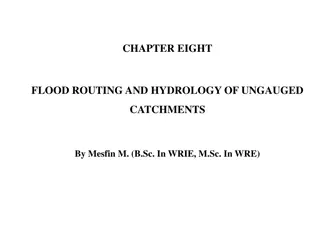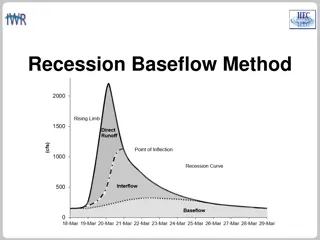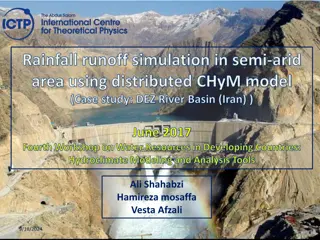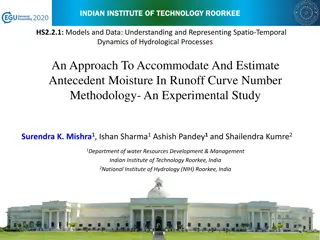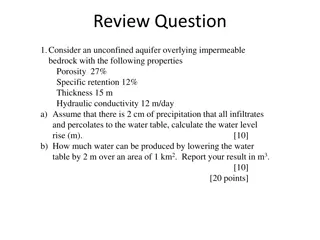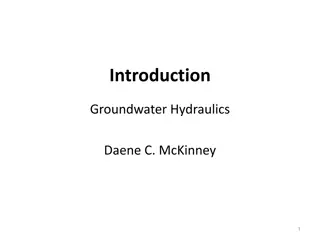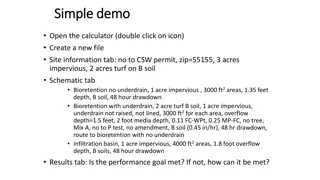Understanding Hyetograph, Runoff, and Hydrograph in Hydrology
A hyetograph represents rainfall intensity over time, crucial for predicting extreme floods. Runoff is the unevaporated portion of rainfall that flows into rivers or oceans, while hydrograph displays discharge variations over time in streams. Surface runoff, interflow, and base flow are key classifications of runoff. Hydrograph analysis is vital for studying surface runoff and deriving unit hydrographs.
Download Presentation

Please find below an Image/Link to download the presentation.
The content on the website is provided AS IS for your information and personal use only. It may not be sold, licensed, or shared on other websites without obtaining consent from the author. Download presentation by click this link. If you encounter any issues during the download, it is possible that the publisher has removed the file from their server.
E N D
Presentation Transcript
CONTENTS : 1. Hyetograph 2. Runoff 3. Classification of runoff 4. Hydrograph 5. Unit HydrographAnalysis 6. Hydrograph Vocabulary
HYETOGRAPH A hyetograph is a graphical representation of the relationship between the rainfall intensity and time. It is the plot of the rainfall intensity drawn on the ordinate axis against time on the abscissa axis. The hyetograph is a bar diagram. The area under the hyetograph gives the total rainfall occurred in that period. This chart is very useful in representing the characteristics of storm, and is particularly important in developing the design storm to predict extreme floods.
RUNOFF Runoff is that portion of rainfall that is not evaporated. The runoff is defined as the portion of the rainfall that makes its way towards river or ocean as surface or subsurface flow. The discharge flowing in a river is the runoff from the basin drained by that river. Runoff is usually expressed as volume per unit time, the common unit being m3/s or cumec.
When rainfall starts, some gets caught in retention storage depressions where it will be evaporated again, but some enters the ground (infiltration, including some from detention storage) where it will contribute to the channel flow at some later time.
Classification of Runoff Surface runoff: Water flows over the land and is first to reach the streams and rivers which ultimately discharge the water to the sea. Inter flow or subsurface flow: A portion of rainfall infiltrates into surface soil and depending upon the geology of basins, runs as subsurface runoff and reaches the streams and rivers. Ground water flow or base flow: It is that portion of rainfall which after infiltration, percolates down and joins the ground water reservoir which is ultimately connected to the ocean.
HYDROGRAPH A hydrograph is a graphical plot of discharge of a natural stream or river versus time. It shows variations of discharge with time, at a particular point of a stream. It also shows the time distribution of total runoff at the point of measurement. Discharge is plotted on Y-axis and the corresponding time is plotted on X-axis. Flood analysis and derivation of unit hydrograph a single peaked hydrograph is required. Hydrograph analysis is the most widely used method of analyzing surface runoff.
Hydrograph determines the peak flood magnitude of flood for the design of hydraulic structures i.e. a dam, spilway, bridge, culvert, etc. Hydrographs are also described in terms of the following time characteristics : 1) Time to Peak, tp: Time from the beginning of the rising limb to the occurrence of the peak discharge. The time to peak is largely determined by drainage characteristics such as drainage density, slope, channel roughness, and soil infiltration characteristics. Rainfall distribution in space also affects the time to peak.
2.) Time of Concentration, tc: Time required for water to travel from the most hydraulically remote point in the basin to the basin outlet. For rainfall events of very long duration, the time of concentration is associated with the time required for the system to achieve the maximum or equilibrium discharge. The drainage characteristics of length and slope, together with the hydraulic characteristics of the flow paths, determine the time of concentration.
3.) Lag Time, tl: Time between the center of mass of the effective rainfall hyetograph and the center of mass of the direct runoff hydrograph. The basin lag is an important concept in linear modeling of basin response. The lag time is a parameter that appears often in theoretical and conceptual models of basin behavior. However, it is sometimes difficult to measure in real world situations. Many empirical equations have been proposed in the literature. The simplest of these equations computes the basin lag as a power function of the basin area. 4.) Time Base, tb: Duration of the direct runoff hydrograph.
UNIT HYDROGRAPH ANALYSIS Sherman (1932) first proposed the unit hydrograph concept. The Unit Hydrograph (UH) of a watershed is defined as the direct runoff hydrograph resulting from a unit volume of excess rainfall of constant intensity and uniformly distributed over the drainage area. The duration of the unit volume of excess or effective rainfall, sometimes referred to as the effective duration, defines and labels the particular unit hydrograph. The unit volume is usually considered to be associated with 1 cm (1 inch) of effective rainfall distributed uniformly over the basin area.
HYDROGRAPHVOCABULARY Rising limb, a falling limb, and a recession. The rising limb and falling limb are separated by the hydrograph crest, and the limbs are separated from the recession by inflection points. The rising limb is typically steeper than the falling limb.
The rising limb :- The rising limb is the ascending portion of the hydrograph corresponding to the increase of discharge due to gradual accumulation of storage in the channels existing in the area and also over the watershed surface. The rising limb is also known as the concentration curve. The peak or crest :- The peak or crest segment includes the part of the hydrograph from the inflection point on the rising limb to an inflection point on the recession limb. The peak segment is the most important part of the hydrograph because it indicates the peak flow rate. The peak represents the arrival of flow at the outlet from all parts of the basin.
The recession limb :- After the inflection point, there is no inflow to the stream due to surface runoff. The recession limb extends from the inflection point, to the point of recommencement of the natural base flow or ground water flow. The recession limb represents the withdrawl of water from the storage already built up in the catchment during the earlier phase of the hydrograph when surface runoff was occuring.





